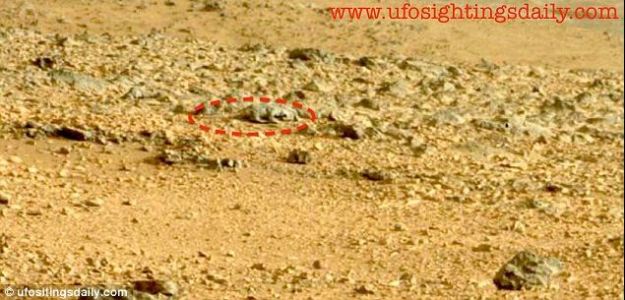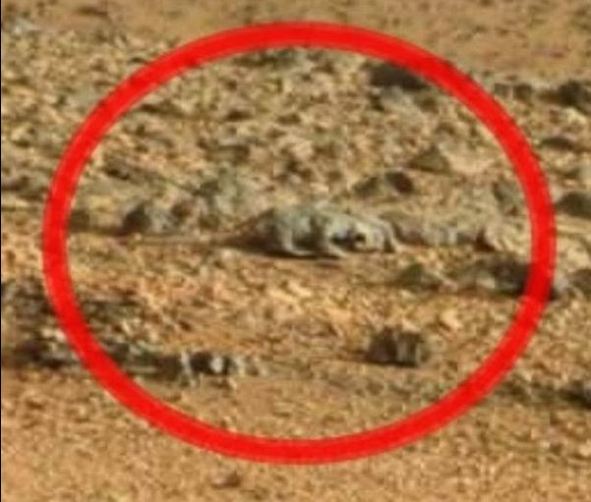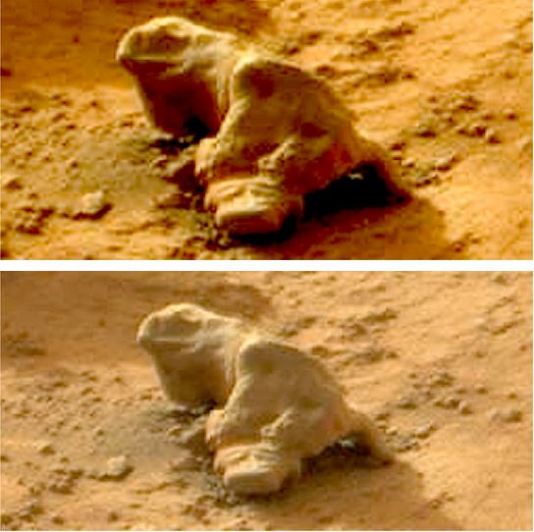The planet Mars is a subject of much interest and speculation among the general public. Unfortunately, people do not always seek out good sources of information when feeding their fascination of the red planet. Reputable scientists are just as interested in probing and learning the secrets of Mars as are pseudoscientists, but the latter group is often troublingly effective at appealing to the public’s imagination at the expense of their rational, fact-checking capabilities.
This observation is strongly attested by breathless Martian news that has come from the pseudoscience camp, courtesy of UFOlogist Scott C. Waring. Formerly affiliated with the United States Air Force, Waring now lives in Taiwan where he teaches English as a secondary language (which is potentially frightening, since his written English is atrocious). He is the author of a children’s fantasy novel and founding owner of the not-so-reputable website UFO Sightings Daily. The November 6, 2013 headline there reads, “Iguana Found on Mars by NASA Curiosity Rover.”
Waring tells us that in one of Curiosity’s many photos, taken from the official NASA archives, there is something on the planet Mars that bears a resemblance to an iguana:
This is an interesting picture, and Waring’s interpretation of the object in the image has attracted the attention of several news outlets, including the UK-based Mail Online, Canada’s Agora Cosmopolitan, and Fox News. But we are not looking at an iguana meandering in some ancient Martian waterbed, as UFO Sightings Daily claims. For one thing, it is clearly not an organic object. And if this was once a living animal that has been fossilized, how was the animal petrified with its eyes open and stuck in a distinctive pose? Here is where an added dose of Scott Waring’s tabloid sensationalism could be of help to him. He could simply assert that a Martian Medusa turned the iguana into stone instantly.
No, this is a photo of a rock. It looks like a rock, and it is a rock. This is a very amusing and uncanny example of pareidolia. Not everyone who looks at the photo will agree that it looks like an iguana, or even a lizard of any kind. The ostensible creature is missing its paws and it appears as though part of its leg is missing. Moreover, its tail is highly questionable. In fact, the whole back end of the thing is clearly a mess. If the object in the photo was shown from any different angle, the iguana perception would dissolve. Waring is clearly overselling his impression.
But our USD scientician insists otherwise, saying that the evidence is very straightforward and undeniable. “To say its [sic] just a rock would be very closed minded to the evidence at hand,” Waring writes. He then provides a list of these “evidences”:
1st off this is not the first animal found on Mars, actually there have been about 10-15 to date. I even found a rock that moved four times in four photos…then vanished on the fifth.
2nd, this mars [sic] iguana looks back and cocks its head in a manner fitting that of a[n]…iguana.
3rd, not only does it have a body, but look closely and you will see its lower neck skin, its mouth line, nostril hole and even an open eye with a large brow over it.
Waring’s first point does not constitute evidential data for his claim. It is simply an extension of his iguana claim to include other animals. Even if it was true that 10-15 genuine animals were spotted before the iguana, this would not in itself indicate that the rock in the photograph is actually an iguana. It is also instructive to point out that there are hundreds, perhaps thousands, of photographs from Curiosity’s cameras, which have been snapping away since the rover’s arrival on the Martian surface on August 6, 2012. This means that people like Waring can wade through the Curiosity photo archives and look at thousands and thousands of Martian rocks until they see a few that accidentally resembles anything.
As for Waring’s second and third points, these are nothing more than restatements of his original claim that the rock looks like an iguana. But he still has three more “arguments” that he thinks supports the validity of his sighting:
4th, if an animal were to live on the red planet, it would be logical that it would have to be small and tough enough to survive in its surroundings. And don’t ask me what it eats…I don’t live on Mars!
Here Waring is once again not providing evidence that what we see in the picture is a petrified iguana. He is making irrelevant observations about what the physical constitution of a creature would have to be like to survive the Martian environment. He still has not demonstrated that iguanas actually have been or are living on Mars.
My question to Scott Waring is this: Is it “logical” to accept that a species of lizard can survive in an atmosphere that is only 1 percent that of Earth’s, on a planet whose gravity is only about 25 percent of Earth’s gravity? Waring seems to be willfully overlooking a huge discontinuity here. And we are justified in asking Waring what his Martian iguana would eat. The fact that nobody lives on Mars does not give any credence to an argument from ignorance.
5th, this iguana is looking back…watching the Curiosity rover to see what its [sic] going to do.
How do you know this, Scott? Imaginative scenarios do not constitute informational data. For all the evidence you don’t have for your claim, you could just as well say that the alleged iguana is looking back to watch the approach of Bigfoot, who has also allegedly been spotted on Mars.
6th, an iguana, at least on Earth, often do [sic] not drink much water in their life, but get their moisture from the air and their food source.
This last piece of “evidence” is similar to the third point above, in that it is an irrelevant physiological/biological observation about iguanas on Earth.
Another Lizard on Mars
This is not the first instance of someone allegedly spotting a lizard on the red planet. Earlier this year, in March 2013, an unknown blogger from Japan noticed the profile of a lizard in one of NASA’s photos. Waring was alerted to this photo in May and posted news of the sighting on USD with the headline “Alien Creature Caught in NASA Photo by Curiosity Rover, Lizard or Rodent”:

 This thing appears to sport a long tail and an interestingly-shaped head. Most compellingly, this rock appears to feature two legs on the side of its body that can be seen, making it easy to infer a four-legged creature.
This thing appears to sport a long tail and an interestingly-shaped head. Most compellingly, this rock appears to feature two legs on the side of its body that can be seen, making it easy to infer a four-legged creature.
However, closer study of this photograph will show that there is no “tail” in the image at all. The long, thin accessory trailing behind is not part of the rock. It is an optical illusion, created by a scratch in the Martian ground. What we are looking at is not a creature with a tail. It is a rock situated by an optical illusion that looks like a tail. Simple pareidolia explains these and other creature sightings on Mars.
Cue the conspiracy theories in 3 … 2 … 1 …
The claim about the Martian lizard with the illusory tail, combined with an earlier report from the pareidolia-stricken Waring in which he claimed to have spotted a squirrel or rodent in NASA’s Mars photographs, has created a stir among conspiracy theorists. Their idea is that NASA may have secretly placed animals into the Mars rover. In the words of Waring,
With water existing on Mars in small amounts, its [sic] possible to find such desert animals wandering around…although very rare mind you. Then again, is NASA placing animals from tiny cyogenic [sic] chambers inside the rover onto the surface of Mars to conduct tests?
The reasoning here seems to be that if we are eventually going to colonize Mars with people (and we probably will many generations from now), it would be useful to conduct experiments that show scientists exactly how live animals fare on the red planet.
But this would also mean that the sneaky scientists responsible for sending the animals to Mars carelessly allowed their test subjects to run loose on the planet so that Curiosity’s cameras accidentally captured them in photographs. The great secret the NASA scientists went to great lengths to hide has been revealed by people who spend all their time straining to find anomalies in the Mars photographs that fuel their wild fantasies. Does this sound plausible?
These alleged sightings of various animals on Mars have engendered another conspiracy theory that goes even deeper than the one described above. Several commenters on Waring’s site and others are declaring that Waring’s photos constitute definitive proof that we never sent any rover to Mars. Following are some representative examples of such comments:
[O]nly thing this proofs [sic] AGAIN is that photos of Mars are just taken on earth in the desert. [T]here is no reason to deny for NASA that there is a[n] iguana walking around, simply desert photos like before…in my opinion there is not 1 valid Mars photo, makes you think. they never made it…. to say of course there is life on mars is a big thing and there is no REAL proof of it at all these photos i [sic] can make in my backyard when i [sic] dig a hole and throw in some stones that have been in the sun for a month, stay realistic and do not say ‘SURE’ because you not sure, just like ‘i [sic] do not know what they eat’ you also do not know or it are real mars photos or it is a[n] iguana, looks like a rock to me.
~ Admin, from UFO Sightings Daily comments sectionThe most likely situation is that it is an actual lizard – but it ain’t on Mars. I think that the images of ‘Mars’ were taken from a desert here on earth, and that NASA has duped us into thinking there is a Mini Cooper sized rover trundling around a planet millions of miles away from here.
~ PJ, from Mail Online (UK) comments sectionTotal liesssss. They want us to believe in a new scare so they can tell is [sic] what to think for the next 10 years it will all be about alien discovery… hoax.
~ mzaman, from Mail Online (UK) comments section
According to these people, all of Curiosity’s photos were taken here on Earth and are part of a grand conspiracy to make us believe that NASA has the technology and know-how to send exploratory vehicles to Mars. The proof is before our eyes: the conniving scientists have accidentally taken pictures of rocks that look like iguanas!
My advice to Scott Waring is that he should stick to writing children’s fantasy stories. But I am not sure how seriously would he take this suggestion, considering that writing children’s fantasy stories is all he ever does on his blog.


Pingback: Demythologizing the Martian Beacon | Skeptical Inquests: A Blog by Nathan Dickey
Old story, interesting photo(s). What evidence/lack of evidence is there that curiosity captured a fossilized iguana or iguana like animal? I personally don’t discount pareidolia as the most likely thing in play here but I don’t yet see a reason to discount the idea that mars once sustained life forms that are similar to the ones we know on earth and a a geologic record of on earth that goes back millions of years. The more improbable piece to me would be that curiosity, having traveled less than 2km in a year should chance upon a fossil so tantalizing. I am guessing one has a substantially better chance of winning the powerball lottery than finding an interesting fossil in a patch of land perhaps 1km sq.